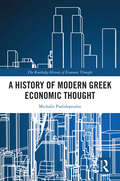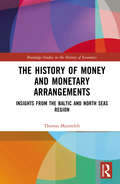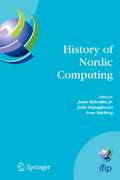- Table View
- List View
A History of Modern Greek Economic Thought (The Routledge History of Economic Thought)
by Michalis PsalidopoulosTracing the evolution of economic ideas in the context of the economic history and economic policy issues in Greece, this book examines the history of modern Greek economic thought from the War of Independence from Ottoman rule in 1821 until the present.The book explores how native, religious-oriented economic thought was secularized and merged with different economic discourses during successive historical periods. It traces how the dissemination of French and German economic thought in the 19th century was followed by British and US influences in the 20th century. The institutionalization of economics as a discipline in the 1920s and its internationalization after 1971, with their effects on the emergence of modern mainstream and heterodox thought, are also discussed. Finally, reference is made to contemporary Greek economic thought in the frame of European Union economic thinking.This book will be of interest to readers in the history of economic thought, economic history, intellectual history, Greek history, and modern European history more broadly.
A History of Modern Shanghai Banking: The Rise and Decline of China's Financial Capitalism (Studies On Modern China Ser.)
by Ji ZhaojinAs the center of capitalism in China, Shanghai banking provides a unique perspective for assessing the impact of the changes from financial capitalism to socialist planning banking in the early 1950s, and for evaluating the reform of China's banking system since the 1980s. This book offers a comprehensive history of Shanghai banking and capital markets from 1842 to 1952, and illustrates the non-financial elements that contributed to the revolutionary social and financial changes since the 1950s, as well as financial experiences that are significant to China's economic development today. The book describes the rise and fall of China's traditional native banks, the establishment of foreign banks, and the creation of modern state banks, while focusing on the colorful world of banking, finance, and international relations in modern Shanghai. It assesses the Chinese government's intervention in banking and finance during the Qing dynasty and the Republican era, as well as the concept of state capitalism after the establishment of the People's Republic. The author examines various modern-style Chinese banks through fascinating stories of Shanghai bankers. In addition, she provides detailed coverage of market-oriented international trade, banking associations, the conflicts between state and society, the government involvement in business, the management of foreign exchange, joint venture banks, wartime banking and finance, hyperinflation, corruption, and banking nationalization.
A History of Modern Shanghai Banking: The Rise and Decline of China's Financial Capitalism
by Ji ZhaojinAs the center of capitalism in China, Shanghai banking provides a unique perspective for assessing the impact of the changes from financial capitalism to socialist planning banking in the early 1950s, and for evaluating the reform of China's banking system since the 1980s. This book offers a comprehensive history of Shanghai banking and capital markets from 1842 to 1952, and illustrates the non-financial elements that contributed to the revolutionary social and financial changes since the 1950s, as well as financial experiences that are significant to China's economic development today. The book describes the rise and fall of China's traditional native banks, the establishment of foreign banks, and the creation of modern state banks, while focusing on the colorful world of banking, finance, and international relations in modern Shanghai. It assesses the Chinese government's intervention in banking and finance during the Qing dynasty and the Republican era, as well as the concept of state capitalism after the establishment of the People's Republic. The author examines various modern-style Chinese banks through fascinating stories of Shanghai bankers. In addition, she provides detailed coverage of market-oriented international trade, banking associations, the conflicts between state and society, the government involvement in business, the management of foreign exchange, joint venture banks, wartime banking and finance, hyperinflation, corruption, and banking nationalization.
History of Monetary and Credit Theory: From John Law to the Present Day (Routledge Library Editions: Landmarks in the History of Economic Thought)
by Charles RistOriginally published in 1940, this book traces the development of theories concerning currency and credit from the beginning of the eighteenth century to the middle of the twentieth. It provides a comprehensive account of the political and economic conditions in which the theories and controversies arose, with the result that the work has become a classic in its field.
History of Monetary and Credit Theory: From John Law to the Present Day (Routledge Library Editions: Landmarks in the History of Economic Thought)
by Charles RistOriginally published in 1940, this book traces the development of theories concerning currency and credit from the beginning of the eighteenth century to the middle of the twentieth. It provides a comprehensive account of the political and economic conditions in which the theories and controversies arose, with the result that the work has become a classic in its field.
History of Monetary Policy in India Since Independence (SpringerBriefs in Economics)
by Ashima GoyalThe book discusses Indian post-independence monetary history in the context of the country’s development and the global changes of the period. The conceptual framework used is the SIIO (Structure, Ideas, Institutions and Outcomes) paradigm. That is, structure and ideas become embedded in institutions and affect outcomes. Narrative history, data analysis and research reports demonstrate the dialectic between ideas and structure with respect to monetary history, aspects of India’s development, and the global institutions and events that impacted monetary choices. The history of the economy and of the global changes that affected it covers a time when major changes took place both in India and internationally.India’s greater openness is important both for it and for the world, but it occurred at a time of major global crises. How did these impact monetary choices and how did the latter help India navigate the crises while maintaining its trajectory towards greater liberalization? The book explores these and other relevant but under-analyzed questions.The initial combination of ideas and structure created fiscal dominance and made monetary policy procyclical. An aggregate supply-and-demand framework derived from forward-looking optimization subject to Indian structural constraints is able to explain growth and inflation outcomes in the light of policy actions. Using exogenous supply shocks to identify policy shocks and to isolate their effects, demonstrate that policy was sometimes exceedingly strict despite the common perception of a large monetary overhang. Surges and sudden stops in capital flow also constrained policy.But the three factors that cause a loss of monetary autonomy—governments, markets and openness—moderate each other. Markets moderate fiscal profligacy and global crises moderate market freedoms and ensure openness remains a sequenced and gradual process. The book argues greater current congruence between ideas and structure is improving institutions and contributing to India’s potential.
A History of Money: From AD 800
by John F ChownThis book presents a detailed and surprising history of money from Charlemagne's reform in approximately AD800 to the end of the Silver Wars in 1896. It also summarizes twentieth century developments and places them in their historical context.
A History of Money: From AD 800
by John F ChownThis book presents a detailed and surprising history of money from Charlemagne's reform in approximately AD800 to the end of the Silver Wars in 1896. It also summarizes twentieth century developments and places them in their historical context.
The History of Money and Monetary Arrangements: Insights from the Baltic and North Seas Region (Routledge Studies in the History of Economics)
by Thomas MarmefeltToday, most money is credit money, created by commercial banks. While credit can finance innovation, excessive credit can lead to boom/bust cycles, such as the recent financial crisis. This highlights how the organization of our monetary system is crucial to stability. One way to achieve this is by separating the unit of account from the medium of exchange and in pre-modern Europe, such a separation existed. This new volume examines this idea of monetary separation and this history of monetary arrangements in the North and Baltic Seas region, from the Hanseatic League onwards. This book provides a theoretical analysis of four historical cases in the Baltic and North Seas region, with a view to examining evolution of monetary arrangements from a new monetary economics perspective. Since the objective exhange value of money (its purchasing power), reflects subjective individual valuations of commodities, the author assesses these historical cases by means of exchange rates. Using theories from new monetary economics , the book explores how the units of account and their media of exchange evolved as social conventions, and offers new insight into the separation between the two. Through this exploration, it puts forward that money is a social institution, a clearing device for the settlement of accounts, and so the value of money, or a separate unit of account, ultimately results from the size of its network of users. The History of Money and Monetary Arrangements offers a highly original new insight into monetary arrangments as an evolutionary process. It will be of great interest to an international audience of scholars and students, including those with an interest in economic history, evolutionary economics and new monetary economics.
The History of Money and Monetary Arrangements: Insights from the Baltic and North Seas Region (Routledge Studies in the History of Economics)
by Thomas MarmefeltToday, most money is credit money, created by commercial banks. While credit can finance innovation, excessive credit can lead to boom/bust cycles, such as the recent financial crisis. This highlights how the organization of our monetary system is crucial to stability. One way to achieve this is by separating the unit of account from the medium of exchange and in pre-modern Europe, such a separation existed. This new volume examines this idea of monetary separation and this history of monetary arrangements in the North and Baltic Seas region, from the Hanseatic League onwards. This book provides a theoretical analysis of four historical cases in the Baltic and North Seas region, with a view to examining evolution of monetary arrangements from a new monetary economics perspective. Since the objective exhange value of money (its purchasing power), reflects subjective individual valuations of commodities, the author assesses these historical cases by means of exchange rates. Using theories from new monetary economics , the book explores how the units of account and their media of exchange evolved as social conventions, and offers new insight into the separation between the two. Through this exploration, it puts forward that money is a social institution, a clearing device for the settlement of accounts, and so the value of money, or a separate unit of account, ultimately results from the size of its network of users. The History of Money and Monetary Arrangements offers a highly original new insight into monetary arrangments as an evolutionary process. It will be of great interest to an international audience of scholars and students, including those with an interest in economic history, evolutionary economics and new monetary economics.
The History of Music Production
by Richard James BurgessIn The History of Music Production, Richard James Burgess draws on his experience as a producer, musician, and author. Beginning in 1860 with the first known recording of an acoustic sound and moving forward chronologically, Burgess charts the highs and lows of the industry throughout the decades and concludes with a discussion on the present state of music production. Throughout, he tells the story of the music producer as both artist and professional, including biographical sketches of key figures in the history of the industry, including Fred Gaisberg, Phil Spector, and Dr. Dre. Burgess argues that while technology has defined the nature of music production, the drive toward greater control over the process, end result, and overall artistry come from producers. The result is a deeply knowledgeable book that sketches a critical path in the evolution of the field, and analyzes the impact that recording and disseminative technologies have had on music production. A key and handy reference book for students and scholars alike, it stands as an ideal companion to Burgess's noted, multi-edition book The Art of Music Production.
The History of Music Production
by Richard James BurgessIn The History of Music Production, Richard James Burgess draws on his experience as a producer, musician, and author. Beginning in 1860 with the first known recording of an acoustic sound and moving forward chronologically, Burgess charts the highs and lows of the industry throughout the decades and concludes with a discussion on the present state of music production. Throughout, he tells the story of the music producer as both artist and professional, including biographical sketches of key figures in the history of the industry, including Fred Gaisberg, Phil Spector, and Dr. Dre. Burgess argues that while technology has defined the nature of music production, the drive toward greater control over the process, end result, and overall artistry come from producers. The result is a deeply knowledgeable book that sketches a critical path in the evolution of the field, and analyzes the impact that recording and disseminative technologies have had on music production. A key and handy reference book for students and scholars alike, it stands as an ideal companion to Burgess's noted, multi-edition book The Art of Music Production.
The History Of Music Production (PDF)
by Richard James BurgessRichard James Burgess draws on his experience as a producer, a musician, and an author in this history of recorded music, which focuses on the development of music production as both art form and profession.
A History of Natural Resources in Asia: The Wealth of Nature
by G. Bankoff P. BoomgaardMuch has been written about the wealth of nations, the history of unequal distribution and zones of affluence and deprivation within and between societies. This book explores why some Asian nations are more prosperous than others through an examination of how their interaction with and utilization of resources has changed over the centuries.
History of Nordic Computing: IFIP WG9.7 First Working Conference on the History of Nordic Computing (HiNC1), June 16-18, 2003, Trondheim, Norway (IFIP Advances in Information and Communication Technology #174)
by Janis Bubenko John Impagliazzo Arne SoelvbergComputing in the Nordic countries started in late 1940s mainly as an engineering activity to build computing devices to perform mathematical calculations and assist mathematicians and engineers in scientific problem solving. The early computers of the Nordic countries emerged during the 1950s and had names like BARK, BESK, DASK, SMIL, SARA, ESKO, and NUSSE. Each of them became a nucleus in institutes and centres for mathematical computations programmed and used by highly qualified professionals. However, one should not forget the punched-card machine technology at this time that had existed for several decades. In addition, we have a Nordic name, namely Frederik Rosing Bull, contributing to the fundaments of punched card technology and forming the French company Bull. Commercial products such as FACIT EDB and SAAB D20-series computers in Sweden, the Danish GIER computer, the Nokia MIKKO computer in Finland, as well as the computers of Norsk Data in Norway followed the early computers. In many cases, however, companies and institutions did not further develop or exploit Nordic computing hardware, even though it exhibited technical advantages. Consequently, in the 1970s, US computers, primarily from IBM, flooded the Nordic market.
History of Nordic Computing 2: Second IFIP WG 9.7 Conference, HiNC 2, Turku, Finland, August 21-23, 2007, Revised Selected Papers (IFIP Advances in Information and Communication Technology #303)
by John Impagliazzo Timo Järvi Petri PajuThe First Conference on the History of Nordic Computing (HiNC1) was organized in Trondheim, in June 2003. The HiNC1 event focused on the early years of computing, that is the years from the 1940s through the 1960s, although it formally extended to year 1985. In the preface of the proceedings of HiNC1, Janis Bubenko, Jr. , John Impagliazzo, and Arne Sølvberg describe well the peculiarities of early Nordic c- puting [1]. While developing hardware was a necessity for the first professionals, quite soon the computer became an industrial product. Computer scientists, among others, grew increasingly interested in programming and application software. P- gress in these areas from the 1960s to the 1980s was experienced as astonishing. The developments during these decades were taken as the focus of HiNC2. During those decades computers arrived to every branch of large and medium-sized businesses and the users of the computer systems were no longer only computer s- cialists but also people with other main duties. Compared to the early years of comp- ing before 1960, where the number of computer projects and applications was small, capturing a holistic view of the history between the 1960s and the 1980s is conside- bly more difficult. The HiNC2 conference attempted to help in this endeavor.
History of Nordic Computing 3: Third IFIP WG 9.7 Conference, HiNC3, Stockholm, Sweden, October 18-20, 2010, Revised Selected Papers (IFIP Advances in Information and Communication Technology #350)
by John Impagliazzo Per Lundin Benkt WanglerThis book constitutes the refereed post-proceedings of the Third IFIP WG 9.7 Conference on the History of Nordic Computing, HiNC3, held in Stockholm, Sweden, in October 2010. The 50 revised full papers presented together with a keynote address and a panel discussion were carefully reviewed and selected from numerous submissions. The papers focus on the application and use of ICT and ways in which technical progress affected the conditions of the development and use of ICT systems in the Nordic countries covering a period from around 1970 until the beginning of the 1990s. They are organized in the following topical sections: computerizing public sector industries; computerizing management and financial industries; computerizing art, media, and schools; users and systems development; the making of a Nordic computing industry; Nordic networking; Nordic software development; Nordic research in software and systems development; teaching at Nordic universities; and new historiographical approaches and methodological reflections.
History of Nordic Computing 4: 4th IFIP WG 9.7 Conference, HiNC 4, Copenhagen, Denmark, August 13-15, 2014, Revised Selected Papers (IFIP Advances in Information and Communication Technology #447)
by Christian Gram Per Rasmussen Søren Duus ØstergaardThis book constitutes the refereed post-proceedings of the 4th IFIP WG 9.7 Conference on the History of Nordic Computing, HiNC 4, held in Copenhagen, Denmark, in August 2014. The 37 revised full papers were carefully reviewed and selected for inclusion in this volume. The papers focus on innovative ICT milestones that transformed the nordic societies and on the new ideas, systems and solutions that helped creating the welfare societies of today, in particular solutions and systems for public services, e.g., tax, social benefits, health care and education; solutions and systems for the infrastructure of the society, e.g., banking, insurance, telephones, transport and energy supply; and technologies and IT policies behind the major IT milestones, e.g., user centric innovation, programming techniques and IT ethics. They are organized in topical sections on IT policy, infrastructure, public services, private services, telesystems, health care, IT in banking, transport and IT technology.
A History of Organizational Change: The case of Fédération Internationale de l’Automobile (FIA), 1946–2020
by Hans Erik NæssThis book is the first independent exploration of the Fédération Internationale de l’Automobile’s (FIA) institutional history. Virtually unexamined compared with similar institutions like the FIFA and the IOC, the FIA has nevertheless changed from being a small association in 1904 to becoming one of the world’s most influential sport governing bodies. Through chronologically organised chapters, this book explains how the FIA manages to link together motorsport circuses like Formula 1 with the automotive industry and societal issues like road safety and environmental sustainability. In an exciting narrative spanning seven decades, it reviews the FIA’s organisational turning points, governing controversies, political dramas and sporting tragedies. Considering the FIA to be a unique type of hybrid organisation characterised by what the author calls ‘organisational emulsion’, this case study contains theoretical innovations relevant to other studies of sport governing bodies. It makes an empirically grounded contribution to the research fields of institutional logics, historical sociology and sport governance.
The History of Physics in Cuba (Boston Studies in the Philosophy and History of Science #304)
by Angelo Baracca Jürgen Renn Helge WendtThis book brings together a broad spectrum of authors, both from inside and from outside Cuba, who describe the development of Cuba's scientific system from the colonial period to the present. It is a unique documentation of the self-organizing power of a local scientific community engaged in scientific research on an international level. The first part includes several contributions that reconstruct the different stages of the history of physics in Cuba, from its beginnings in the late colonial era to the present. The second part comprises testimonies of Cuban physicists, who offer lively insights from the perspective of the actors themselves. The third part presents a series of testimonies by foreign physicists, some of whom were directly involved in developing Cuban physics, in particular in the development of teaching and research activities in the early years of the Escuela de Física. The fourth part of the volume deals with some of the issues surrounding the publishing of scientific research in Cuba.Cuba’s recent history and current situation are very controversial issues. Little is known about the development and status of higher education and scientific research on the island. However, Cuba has one of the highest proportions in the world of people with a university degree or doctorate and is known for its highly developed medical system. This book focuses on a comprehensive overview of the history of the development of one specific scientific discipline: physics in Cuba. It traces the evolution of an advanced research system in a developing country and shows a striking capacity to link the development of modern research with the concrete needs of the country and its population. A little known aspect is the active participation of several “western” physicists and technicians during the 1960s, the role of summer schools, organized by French, Italian, and other western physicists, as well as the active collaboration with European universities.
A History of Professional Economists and Policymaking in the United States: Irrelevant genius (Perspectives in Economic and Social History)
by Jonathan S. FranklinOver the course of the twentieth century, professional economists have become a feature in the policymaking process and have slowly changed the way we think about work, governance, and economic justice. However, they have also been a frustrating, paradoxical, and in recent years, controversial fixture in American public life. This book focuses on the emergence and growth of professional economics in the U.S., examining the challenges early professional economists faced, which foreshadowed obstacles throughout the twentieth century. From the founding of the American Economic Association in 1885 to the depths of the Great Depression, this volume illustrates why some of the most optimistic and capable economic minds struggled to help smooth economic transitions and tame market fluctuations. Drawing on archival research and secondary sources, the text explores the emergence of professional economics in the United States and explains how economists came to be ‘irrelevant geniuses’. This book is well suited for those who study and are interested in American history, the history of economic thought and policy history.
A History of Professional Economists and Policymaking in the United States: Irrelevant genius (Perspectives in Economic and Social History)
by Jonathan S. FranklinOver the course of the twentieth century, professional economists have become a feature in the policymaking process and have slowly changed the way we think about work, governance, and economic justice. However, they have also been a frustrating, paradoxical, and in recent years, controversial fixture in American public life. This book focuses on the emergence and growth of professional economics in the U.S., examining the challenges early professional economists faced, which foreshadowed obstacles throughout the twentieth century. From the founding of the American Economic Association in 1885 to the depths of the Great Depression, this volume illustrates why some of the most optimistic and capable economic minds struggled to help smooth economic transitions and tame market fluctuations. Drawing on archival research and secondary sources, the text explores the emergence of professional economics in the United States and explains how economists came to be ‘irrelevant geniuses’. This book is well suited for those who study and are interested in American history, the history of economic thought and policy history.
A History of Public Banking in Portugal in the 19th and 20th Centuries (Financial History #28)
by Pedro LainsThis book examines the history of what became one of Portugal’s largest banks, the Caixa Geral de Depósitos. The bank was founded in 1876 by the state to run public deposits, and evolved into a savings bank, catering for both public and private deposits. Its history goes beyond the history of banking, as it ties in with the role of the state in the banking sector and financial markets. The book weaves in and out of different political and international contexts, following the many changes of the Portuguese political regime and of its interactions with the national and international economy. The most important lesson from the study is that publicly owned institutions can compete successfully with the private sector when they simultaneously cater for the interests of policy makers as well as those of the public, in this case, the depositors. The history of the Caixa Geral de Depósitos therefore shows how the state of a peripheral economy is capable of successfully managing a large financial institution when the right set of incentives is in place. This work will be a valuable resource for researchers and students of financial and economic history at both the advanced undergraduate and postgraduate levels. It will also provide interesting insights for practitioners in the financial sector.
A History of Public Banking in Portugal in the 19th and 20th Centuries (Financial History #28)
by Pedro LainsThis book examines the history of what became one of Portugal’s largest banks, the Caixa Geral de Depósitos. The bank was founded in 1876 by the state to run public deposits, and evolved into a savings bank, catering for both public and private deposits. Its history goes beyond the history of banking, as it ties in with the role of the state in the banking sector and financial markets. The book weaves in and out of different political and international contexts, following the many changes of the Portuguese political regime and of its interactions with the national and international economy. The most important lesson from the study is that publicly owned institutions can compete successfully with the private sector when they simultaneously cater for the interests of policy makers as well as those of the public, in this case, the depositors. The history of the Caixa Geral de Depósitos therefore shows how the state of a peripheral economy is capable of successfully managing a large financial institution when the right set of incentives is in place. This work will be a valuable resource for researchers and students of financial and economic history at both the advanced undergraduate and postgraduate levels. It will also provide interesting insights for practitioners in the financial sector.
















